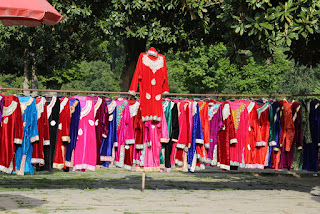I am in Berlin, and trying to write this blog entry at 4 am in the morning. This has long been overdue; though I came back to Delhi after doing the Kedarkantha trek in the second week of January, but the life in Delhi has ever since been too hectic at personal and professional fronts, preventing me to jot down a few lines about the amazing trek and my personal reminisces. But it is not to say that the experience has sunk down deep in my memory lane; I often think, remember, live and cherish the time I had with the group during this snowbound trek in very low tempertatures. Even here I wish to look at the photographs.
I had been
thinking of doing Kedarkantha ever since 2011, when I did Roopkund trek with
the Indiahikes. We were impressed with the logistics and arrangements done by
the Indiahikes, and had wanted to do some more treks with them. Since I had
never done any snow-bound winter trek ever, we zeroed down on Kedarkantha,
which Indiahikes had recently added to its kitty. Meanwhile, Shariff, Malini
(my colleagues) and Vasuman (son) completed the trek long back, and I had to
wait thus far to find or create the opportunity. But then, things are destined,
they say, and I was destined to do this trek with Kushagra, and the fantastic
bunch of 25 young enthusiasts.
Kushagra was
planning to visit us some time in December 2015, but when I told him about my
intention of booking for Kedarkantha trek in the first week of January, he
firmed up his dates immediately to join me for the trek, as he said, ‘it is
quite a while, we had done a trek together’.
When I looked
at the Indiahikes website to book, I was surprised to see that all the suitable
dates for us were already full. It seemed the trek was fast becoming popular. Fortunately,
I had saved some telephone numbers of Indiahikes from my previous trek, and to
my good luck, the numbers were active, working, and when I rang up, someone
immediately put me in touch with Prathima, who assured me of helping us by
accommodating us on our preferred date. She precisely did that. Prathima was
kind of in-charge of the group leaving on 2nd January, and as I
realized, she was mentoring the group throughout.
Fortunately,
I had already been training myself for this trek for last few months by working
out in gym or going for long walks for cardiopulmonary exercises, endurance,
and strengthening my quads and glutes. The significance of training oneself for
any trek cannot be overemphasized, and Prathima too had been reminding the
group members time and again to practice running 4.5 km in 30 minutes. What I
was a little worried about was managing the low temperatures. In the month of January,
it could go as low as minus 10 C. But when Kush arrived in December, he advised
me very precisely how I should layer myself with specialized layers without
overburdening myself. Though his advice was very reassuring, yet the anxieties
remained.
That
Kedarkantha was going to be an exciting trek was never in doubt. After all, the
Indiahikes has labeled this trek as the best ever winter trek. It had given
many reasons in support of its verdict: it remains snow bound from December
till April, prettiest campsites, beautiful drive in Himalayas, pleasure of
walking on a carpet of brown leaves with snow peaks all around. I could vouch
for that. We had done nearby ‘Har-ki-Doon’ trek way back in 1993, and to this
day I find ‘Har-ki-Doon’ as one of most beautiful treks. The exciting part of
Kedarkantha was doing it in winter with snow-laden path under extreme cold conditions.
When I was
preparing myself physically and mentally, Prathima from the Indiahikes was
constantly in touch with all the group members reminding us about how to
prepare ourselves, what all essentials we should carry (no more, no less), what
we should expect by way of arrangements, giving various important contact
numbers etc. The most praiseworthy part was that whenever any member posed any
query on the group email, the response came almost immediately. Meanwhile, one
trek member had soon created a whatsapp group for members to get acquainted
with one another. They were coming from all over, Bengaluru, Pune, Mumbai,
Delhi, Kolkata, and the US.
Little bit
about Kedarkantha: One has to first reach a village by name of Sankari to begin
the trek. The road for Sankari (the
starting point for the trek) starts from Mussourie and passes through Kempty
falls, and some other small towns like Barkot, Purola, to enter the Supin range
of Himalayas. A couple of hours before reaching Sankari, one enters Govind wild
life sanctuary, a protected area. One then views two rivers, Supin and Rupin,
and their confluence, which finally merges with river Yamuna. When a few
decades back, my uncle and auntie were trekking towards Har-ki-Doon, they decided
that whenever they were blessed with a daughter, they would name her Rupin; and
they precisely did that. Now Rupin is a smart young lady, working where else
but Silicon Valley. One then reaches Netwar, a small village, which used to be
the starting point for beginning the trek to Har-ki-Doon way back in early
1990s, since that was the end of road head that time. Now road goes as far as
Sankari. Sankari is a small village of about 400 houses at a height of 1950 m
(6400 ft). It has a GMVN guesthouse of about 15 rooms, and a couple of private guesthouses.
Sankari is now the base camp for both, Har-ki-Doon as well as Kedarkantha. Once
you starting walking up, it is all the way uphill trek amidst lush green
forests of pine, oak and other trees. There are two campsites, Juda ka Talab
and Kedarkantha base camp at very picturesque sites, finally taking you to
Kedarkantha peak at 12,500 ft.
Our journey
from Delhi to Mussourie by train, then onwards to Sankari by SUVs was quite
uneventful. We met up briefly with our batch mates whenever we stopped for
breakfast, tea or lunch on our way up. There were two father-son teams, two
husband-wife teams; many of the members were colleagues or had been friends
since school days. There was a group of 9 from Bengaluru, who had studied
together in school, all graduated from various engineering colleges, and now
were all software engineers in Bengaluru itself. Others were fast becoming
friends with one another. Youngest of the group was 11 year old Shreshtha, and
the oldest was ‘yours truly’.
When we
reached Sankari in the evening, Harshit (trek leader) welcomed us at the guesthouse
along with his team of technical experts, Sarvan and Tarpan, with hot tea and
delicious pakoras. We were tired, and perhaps famished, or the charm of hot
pakoras in a remote area, we ate like hogs. Harshit gave a detailed briefing of
our trek, which I would rate among the best briefings I have ever had. He
explained each point in detail, answered to every query patiently, and did not
mind if there were frequent interruptions or similar questions being asked by
different members. The GMVN guesthouse at Sankari is basic, with spacious and
reasonably clean rooms, toilets with running water, flush working, but no hot
water please. The quilts were heavy but warm, so did not have to struggle for
sleep.
The morning
was bright and sunny, and after a sumptuous breakfast we were ready to trek to
‘Juda ka talaab’. The other groups had
also camped in the village, and their members had left before us. We were to trek
for only 4-5 km, but would gain 2700 ft, so it was an ascent all the way. The
trek passed through a dense forest of pine
and maple trees, and I think there were rhododendrons also; did not see
any wild life, birds were chirping, but too high in the pine trees, so could
not sight any. The climb was not tough, but at places, there was slush, or
frozen snow that made the trek slippery at places. But I was happy that I was
making good progress, and not feeling any fatigue. What I had decided this time
was to necessarily consume 3-4 litres of water every day. That is the key to
success; you prevent dehydration, and it prevents mountain sickness. So by the
time we left Sankari, I had already consumed at least 1.5 lt of water. The
campsite was almost like the size of a football field, and had on its left side
the ‘talab’, the pond, of the size of ‘D’ of the field, was half frozen. We
were now at 9200 ft, and the temperature was falling down rapidly. Though we
had reached quite early in the day, I had decided to enter my tent only after
having my dinner. Meanwhile, Kushagra helped the group do some stretching and
flexibility exercises. I continued with my walking and breathing exercises
preparing myself for the tough part over next two days. I started getting
acquainted with the group members, and had found them to be a fantastic bunch.
More about them later. Later in the afternoon, some members got together to
play ‘pitthu’, known as ‘laghori’ in local language, and also known as ‘seven
stones’. It was fun seeing them running around or away from the ball, or
chasing stones and putting them one on top of other. Meanwhile, the kitchen
staff brought hot tea and ‘chatpata pakoras’. Everyone got together to polish
them fast, but the kitchen staff kept on supplying them till we ourselves could
eat no more. I must say something about the kitchen staff right away. They were
an enthusiastic bunch of young people, who never shied away, whether it was
cooking and serving food in sub-zero temperatures, or pouring rains, or at an
unearthly hour of 3 am. And each meal was a multi-course meal, starting with
starters, soup, main course, and dessert, followed by hot chocolate. To top it,
there was hot water available for washing our cup-plates.
The next day
trek was to Kedarkantha base camp. I wondered why it does not have any other
name. It was at an altitude of 11,400 ft, and of course has no resident
population. From here one could see peaks all around us, but with some haze and
clouds, it was difficult to identify these with names. The trek leader
identified them for us as, Swargrohini, Bunderpoonch, and Kalanag etc. The camp
was a pretty site, with snow all around. Following lunch, people got on to
their own devices. In no time, there was a snowman erected giving all of us
ample opportunity for photographs and selfies. My anxiety levels had starting
increasing. The next day’s ascent to the peak of Kedarkantha was going to be a
steep one, in freezing conditions on snow-covered treks. I was worried about my
fitness, capacity to tolerate low temperatures, and had fear of slipping on
snow trek or frozen ice. Arjun Majumdar’s video on how to layer ourselves in
low temperatures, Kush’s selection of right gear and wear, Harshit’s (trek
leader) assurances to be by my side all the way up, and other members’
enthusiasm and encouragement was much helpful in keeping my morale high. With
the sun setting, the mercury started falling down rapidly, and many of us were
losing our appetite. But it was essential to keep ourselves well nourished and
hydrated. Fortunately, I was drinking enough water, keeping away fatigue as
well as other problems of high altitude.
The night was
cold, but the tents and the sleeping bags, being of good quality, were able to
keep us warm in sub-zero temperatures. But it was difficult to sleep soundly. After
tossing and turning, I woke up very early to get ready for the challenging yet
most exciting day of the trek. We were to trek for 3-4 hours to reach the
summit at 12500 ft. One wanted to enjoy the rising sun and sun-basked peaks in
front, but I was concentrating in maintaining my pace. The peak where we were
to ascend appeared so distant, testing my resolve time and again to walk.
The soft snow
covered trek was now hard ice, taking each step became an effort. In spite of
frequent temptation to stop and rest, I resisted; that would have meant delay
as well as breaking the rhythm. Kush was in front, but keeping an eye on me all
the time. He kept on encouraging and goading me to push myself. What a relief
it was when at some distance I saw our batch mates assembled on a small flat
area at the top, excitedly making noise like school kids during their lunch
break. What an exhilaration it was when I joined them at the top. It was an
unbelievable feeling of excitement, relief, and elation. When Kush hugged me, I
was overwhelmed with emotion. On the top, there was Lord Shiva’s temple. We all
bowed down to pray.
Even when I
had reached the top, it was an humbling experience. As I had written in my
earlier post…
Coming down
was easy and fun. Now we were descending down on the southern ridge, which was
heavily covered with soft snow. We discovered very soon that sliding down on
the snow was the best and fun filled exercise.
We were to
reach Sankari via Hargaon, where we stopped for a night. Just before Sankari,
when I was to take a trail out of so many going down, I heard a melodious voice
cautioning me not to take that trail since trekkers often fell down there. This
young girl was coming from her orchard nearby bringing some fruit. I was
overjoyed when she offered me a kiwi. I did not know kiwi was grown there. I
eagerly peeled and ate it. And I can vouch, never in my life had I tasted a
more delicious fruit of kiwi. She disclosed that she would study to become a
doctor; I wished her well, and thought if somewhere down the line we would be
working together.
A few words
about my batch mates. I had spent some enjoyable time with these young guys
during this trek. Many of them, Sunil, Rishab, Gaurav, Utsav, and Ashish had encyclopaedic
knowledge about computers, smart phones and mobile apps. Some knew all about
movies, whether Hollywood or Bollywood. Milind Tambe, a naval architect, was in
profession of rescuing stranded ships in the ocean. He could also give a tip or
two on photography as well. He has promised to take me along when he goes for
his next rescue operation. I hope he remembers it. Sunil Chauhan could
patiently wait for his panoramic shots and night photography. If you cared to
ask, he would teach you as well. Bengaluru group was a big group, always
willing to help others.
On our last
evening of the trek at Sankari was of sharing our experiences and thanksgiving.
I had a long list of people to thank: to name a few, the Indiahikes team, trek
leader Harshit Patel, Sarvan and Tarpan, all the kitchen and housekeeping team,
the fellow trekkers, and many others. I shared with them a story of fish and
shark. How the presence of shark in ocean or fish tank is crucial to keep fish
alert and active. We all should always have a challenge before us. It acts as a
huge motivating force to keeps us productive, innovative, and full of life.
Kushagra had
been a constant guide before and throughout the trek. On return, he posted the
following lines on his facebook page, the best lines of this trek, “As a young boy this man took me up on my first
trek up the majestic Himalayas leaving me with a deep lasting love for the
outdoors. This week, twenty-five years later, he and I went back for a winter
trek in Uttarakhand to climb up the beautiful Kedarkantha. As he overcame the
bitter cold and severe fatigue to bravely surmount the last couple of miles to
the summit I realized that I'm still following him trying to be half the man he
is. Dad you will always be my hero. Love you. #Himalayas #family #climbing #trekking #India




























